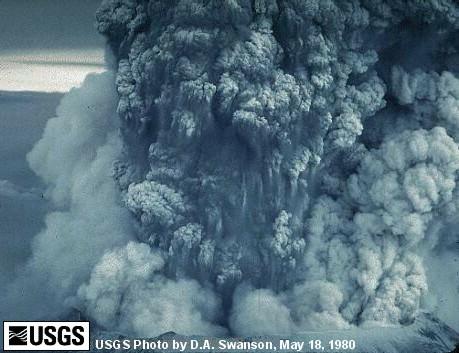

In addition to the areas mentioned above, the U.S. has many other active or potentially active volcanoes -- over 65, which is more than all other countries except for Indonesia and Japan. Most of these volcanoes are located in Alaska, and 55 of them, including 8 on the U.S. mainland, have shown activity since the U. S. was founded, just some 200 years ago.
Eruptions for U.S. volcanoes can generate serious volcanic hazards, any of which can be deadly: glowing rivers of molten rock (lava flows), devastating shock waves and fiery blasts of debris from volcanic explosions (pyroclastic surges), red-hot avalanches of rock fragments racing down mountainsides (pyroclastic flows), and suffocating blankets of volcanic ash falling from the sky (pyroclastic falls). But that is not all. A number of equally deadly processes involve water (Pierson, 1989), and in fact, over 80 percent of the more than 28,500 volcano-related fatalities this past decade were caused by hydrologic processes. Although many hydrologic hazards at volcanoes are directly associated with eruptions, others are not. It is the latter that are especially dangerous because debris avalanches, debris flows, and floods can strike without warning, for example, following periods of heavy rainfall, and they occur with a greater frequency than eruptions. Furthermore, hydrologic hazards typically endanger populations in river valleys considerable distances from their source volcanoes -- as far as 150 kilometers downstream. Within the last few thousand years, large debris avalanches, debris flows, and (or) floods have occurred at most volcanoes in the Cascades and in Alaska (Heath, 1960; Hyde and Crandell, 1978; Riehle and others, 1981; Beget, 1982; Siebert, 1984; Gallino and Pierson, 1985; Cameron and Pringle, 1986; Osterkamp and others, 1986; Riehle and others, 1987; Siebert and others, 1987; Major and Newhall, 1989; Siebert and others, 1989; Nye and Turner, 1990; Scott and others, 1990).
Damaging earthquakes and sea waves (tsunami) may also be closely related to volcanoes and volcanic activity. Large earthquakes related to intrusion of magma into Hawaii's active rift zones of Mauna Loa and Kilauea have caused extensive damage on land and also triggered tsunami in 1868 and 1975 that devastated low-lying coastal areas (Tilling and others, 1976). Large landslides from Alaskan volcanoes near the sea have also generated tsunami that destroyed coastal villages (Kienle and others, 1987). Recent research in Hawaii has shown that much larger tsunami have, in the more distant past, washed as much as 366 meters up on some of the islands (Moore and Moore, 1984). These waves appear to have been generated by gigantic submarine landslides that removed large parts of the Hawaiian volcanoes (Moore and others, 1989). These colossal failures have also torn away and submerged subaerial parts of islands.
A short list of notable eruptions and other volcanic activity at U.S. volcanoes during the 20th century is given in Table 1. A more complete listing of U.S. volcanoes active within the last 2,000 years, as well as older volcanic areas that have active geothermal systems, have shown recent signs of unrest, or which represent a particularly catastrophic event are shown in Appendix 1. Not listed are several dormant volcanic fields on the U.S. mainland that have erupted in the past 10,000-50,000 years and which could erupt again (Smith and Luedke, 1984; Simkin and others, 1981; Miller, 1989). The eruption recurrence intervals for such volcanic fields are large; many of these fields have a deceptively tranquil appearance, show no obvious signs of their violent past, and the land overlying and surrounding these fields is used for agriculture, recreation, or is developed for commercial or residential use. However, the possibility remains that one or more of the currently inactive volcanic fields could erupt again, probably preceded by a period of unrest sufficient to prepare for renewed eruption.
The hazards posed by the U.S. volcanoes provide a fairly complete sampling of hazards shown by volcanoes worldwide. The variety of hazards, in conjunction with the relative abundance of volcanic systems having eruption potential in the U.S., are difficult challenges for the U.S. Geological Survey's Volcano Hazards Program. To address these challenges, we rely on observations and studies made at currently active volcanoes to understand their past histories. The combination of present observations and the reconstructed history of volcanoes, both currently inactive and recently active, allows scientists to estimate the types of hazards and the likelihood of their occurrence for all potentially active or otherwise unstable volcanoes and volcanic areas in the U.S. We recognize, however, that an improved understanding of volcanic processes in itself is insufficient to mitigate volcanic hazards. Effective an timely communication of hazards information to emergency-management authorities before and during a volcanic crisis is equally, if not more, important in reducing volcanic risk. This publication summarizes the Volcano Hazards Program -- its goals, the activities designed to achieve these goals, some key accomplishments of the past two decades, and a plan for work in the 1990's. Additional background information and bibliographic resources on volcanology and volcano hazards are given by Tilling (1989a,b).
Return to:
[Report Menu] ...
